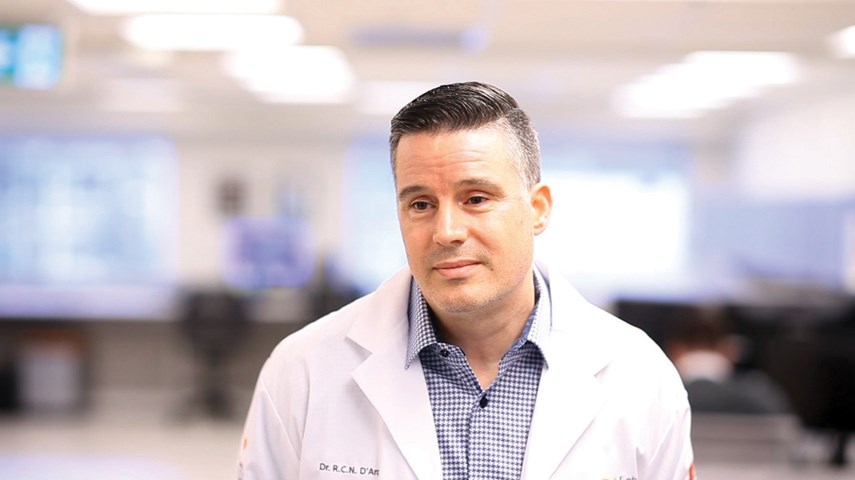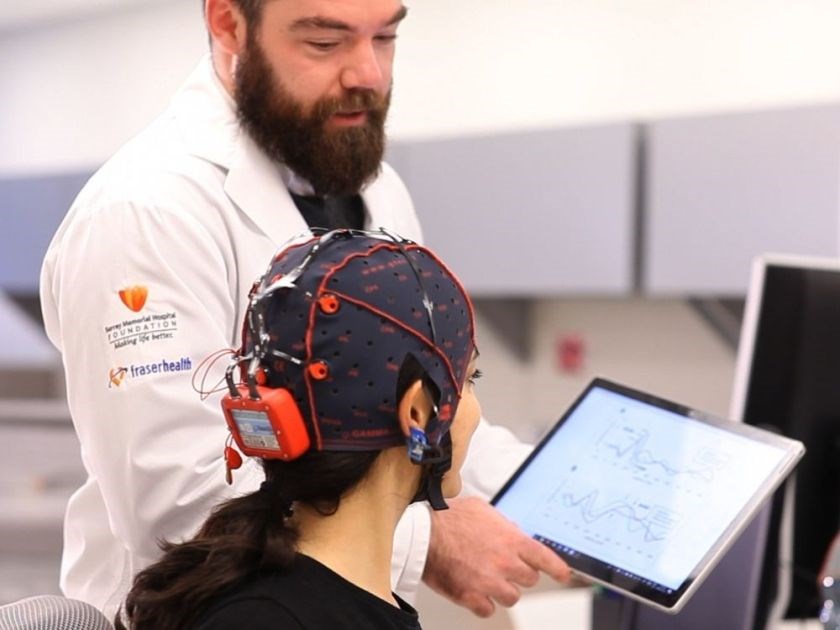A neuroscientist from North Vancouver is one of the lead authors of a new multi-year study that may have a massive impact on how we view brain injuries in hockey.
Simon Fraser University’s Dr. Ryan D’Arcy, co-founder of the Surrey-based Health and Technology District, is the senior author of the joint SFU and Mayo Clinic Sports Medicine Center study based on the research of PhD student and lead author Shaun Fickling. The study used a sensitive tool known as Brain Vital Signs to measure brain activity of players on a junior hockey team in Minnesota over a two-year period.
In an interview with the North Shore News, D’Arcy said that the team’s research, published this week in Brain: A Journal of Neurology, produced three very noteworthy conclusions related to concussions in hockey.
The first was that the Brain Vital Signs test worked very well. It detected significant changes in brain function for players diagnosed with concussions during the study’s time frame, and could be a breakthrough in providing a portable, easy-to-use tool for rink-side concussion testing. The instrument is a portable electroencephalogram, or EEG, that is placed on the scalp and measures brain-wave activity over a 10-minute period. The test subject doesn’t need to do anything except wear the device and listen to auditory stimuli.
“It really is the world’s first objective measuring stick of brain function,” said D’Arcy. “The important word there is objective. The tests for concussion are currently subjective and can be quite error-prone. And it’s not practical to access large medical imaging instruments that are multi-million dollars and away in hospitals and universities when you need these tests at the rinkside. And so what was missing was something that was both physiological and allowed an objective of ‘did your brain function change or not,’ so that you didn’t have to guess or you couldn’t fake it or cheat the test or anything like that. So that’s what this is. It’s taking long-standing science about brain responses and we’ve turned it into an automated, simple and intuitive and rapid test, just like if you go and get your blood pressure at your local drug store.”

The second finding was that during the study’s time frame, players that suffered concussions and were subsequently cleared to play following existing testing protocol were still displaying some impairments in attentional processing, according to the Brain Vital Signs test. So players that were cleared to return to play may not have been actually fully healed, according to the data collected by D’Arcy and his team.
“That’s an important finding, because we do know that the brain isn’t like getting a charley horse on a muscle,” he said. “The recovery time for the brain is definitely longer than the world is aware, and this was demonstrating that. It’s important, because you have that sensitivity to say ‘hang on, we thought you were good but you’re not quite good yet.’”
The third finding may be the most distressing for the hockey world. The researchers found that even players who were never diagnosed with a concussion over the course of a season would show decreases in brain function at the end of the season as compared to the start. The research team has since replicated those results in a study of youth football players in the United States.
“Their cognitive processing speed was significantly slower based on their brainwaves (at the end of the season),” said D’Arcy, likely because of the physical nature of those sports. “That was very noteworthy. Other labs around the world have seen this and this has been reported, and so I think that just helps us all understand that we have to take this very seriously. It’s something we can’t tuck under the rug, we’ve got to address it.”
Those results may have serious implications for the sport, but D’Arcy came away from the study with a lot of optimism.
“The first thing that we’ve got to know is we can’t treat what we can’t measure,” he said. “But as soon as you can measure it, then we can evaluate the best possible treatments and we have the best chance of addressing the problem. So what’s significant about this is we now have this objective measuring stick, which means we can measure, which means we can treat.”
And D’Arcy is not just a scientist – he’s also a hockey dad. His 12-year-old son plays in the North Vancouver Minor Hockey Association and will soon move up to a level that allows body checking.
“It’s definitely something I’m aware of,” he said with a laugh, speaking of his son’s impending move to a hitting league. He takes solace, however, in the fact that we are learning more and more about concussions and the sports world is taking brain injuries seriously.
“When you heighten awareness, there’s a lot of really smart people around the world who are coming up with solutions, and these solutions are starting to come through. It’s actually in some ways very optimistic if you are a father with a son in hockey, because you know it’s not a problem that we can’t solve. It’s not a problem, quite simply, that we can’t manage.
“The awareness also changes some of our cultures. Hockey is an amazing sport and I’m sure there’s a way that with all sports, hockey or others like it, that you can increase the safety. The example I point to is my son and all of the players on his team have the STOP sign on their jerseys. That was a small step, but from a public health point of view, that’s a massive way to help reduce the risk of concussion.”



